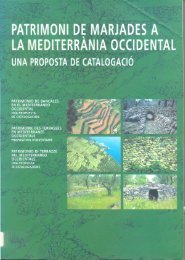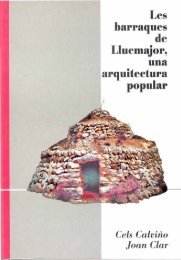La pedra en sec. Materials, eines i tècniques tradicionals a les illes ...
La pedra en sec. Materials, eines i tècniques tradicionals a les illes ...
La pedra en sec. Materials, eines i tècniques tradicionals a les illes ...
Create successful ePaper yourself
Turn your PDF publications into a flip-book with our unique Google optimized e-Paper software.
*** * '<br />
:** *: 6 6.5.4 DRYSTONE MASONRY STRUCTURES<br />
Description<br />
Walled hole in which limestone was<br />
burnt or calcined to obtain lime.<br />
Uses<br />
This lime kiln is called forn de la Mare<br />
de Deu because it was built in 1857 to<br />
produce lime for the capella Fonda<br />
del Roser in the town's parish church<br />
(Ordines, 1995).<br />
Site<br />
Next to the cam! de Coanegra, near<br />
some crags.<br />
<strong>Materials</strong><br />
Limestone, clay, lime.<br />
Ground Plan<br />
Circular.<br />
Facings<br />
The round cavity measuring 1 m in<br />
depth by 5.30 m in diameter and called<br />
the "caixa" (box) has a single vertical<br />
facing which forms the heater. On<br />
the outside it has another wall with a<br />
wide base.<br />
Before calcining the limestone the<br />
interior walls were plastered with clay<br />
or pig muck so that the fire did not<br />
burn them.<br />
Roofing<br />
The drystone masonry roof called pa<br />
de figa (dried fig block) by the lime<br />
kiln workers, is shown in the drawing<br />
in its assumed form. This was not a<br />
perman<strong>en</strong>t feature as it was made of<br />
stone which was to be calcined. Thus<br />
every time lime was made a new roof<br />
had to be built.<br />
A vertical limestone wall called a<br />
pedrfs was built up from the bottom of<br />
the heater and at the op<strong>en</strong>ing the<br />
rows of stones were brought together<br />
to make a vault. At the same time the<br />
"olla" (the cooker) was filled with<br />
wood. Rubble was placed on the vault<br />
and covered with lime and clay leaving<br />
a v<strong>en</strong>t. The roof projected one<br />
metre above the outside walls of the<br />
kiln.<br />
Flooring<br />
The floor of the kiln, called the c<strong>en</strong>drer,<br />
was made of earth.<br />
Op<strong>en</strong>ings<br />
A large op<strong>en</strong>ing was left in the box to<br />
put in the stone and the wood and to<br />
extract the lime. As the kiln filled up<br />
the op<strong>en</strong>ing was covered with a stone<br />
and clay wall called a portada and a<br />
hole was left to light the fire and to<br />
feed it whilst calcining the lime. A<br />
large flat stone called an <strong>en</strong>fornadora<br />
was placed in the middle of the lower<br />
part of the portada at an angle and<br />
flanked by two smaller stones. These<br />
stones made it easier to put in the firewood.<br />
Accessory items<br />
It does not have any accessory items.<br />
Location<br />
Cami de Coanegra, Santa Maria del<br />
Cam!.




